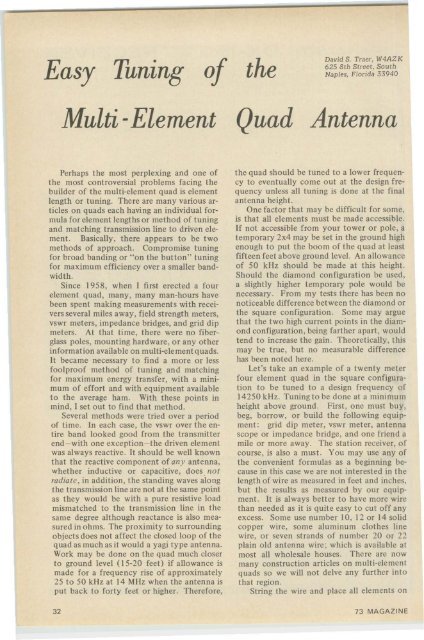rf - Free and Open Source Software
rf - Free and Open Source Software
rf - Free and Open Source Software
- No tags were found...
Create successful ePaper yourself
Turn your PDF publications into a flip-book with our unique Google optimized e-Paper software.
Easy Tuning o the<br />
David S. Traer, W4AZ K<br />
625 8 th S treet , South<br />
Nap les, Florida 33940<br />
Multi -Element Quad Antenna<br />
Perhaps the most perplexing <strong>and</strong> o ne of<br />
the most controversial problems facing the<br />
builder of the multi-element quad is element<br />
length or tuning. There are many various articles<br />
on quads each having an individual formula<br />
for element lengths or method of tuning<br />
<strong>and</strong> matching transmission line to driven element.<br />
Basically, there appears to be two<br />
methods of approach. Compromise luning<br />
for broad b<strong>and</strong>ing or " on the button" tuning<br />
for maximum efficiency over a smaller b<strong>and</strong>width.<br />
Since t 95 8, when I first erected a four<br />
element quad, many, many man-hours have<br />
been spent making measurements with receivers<br />
several miles away, field strengt h meters,<br />
vswr meters, impedance bridges, <strong>and</strong> grid dip<br />
meters. At that time, there were no fiberglass<br />
poles, mounting hardware. or any other<br />
information available on multi-elementquads.<br />
It became necessary to find a more or less<br />
foolproof method of tuning <strong>and</strong> matching<br />
for maximum energy transfer, with a minimum<br />
of effort <strong>and</strong> with equipment available<br />
to the average ham. With these points in<br />
mind, I set out to find that method.<br />
Several methods were tried over a period<br />
of time. In each case. the vswr over the entire<br />
b<strong>and</strong> looked good from the transmitter<br />
end-with one exception - t he driven element<br />
was always reactive. It should be well known<br />
that the reactive component of any antenna,<br />
whether inductive or capacitive, does. not<br />
radiate, in addition, the st<strong>and</strong>ing waves along<br />
the transmission line are not at the same point<br />
as they would be with a pure resistive load<br />
mismatched to the transmission line in the<br />
same degree alt hough reactance is also measured<br />
in ohms. The proximity to surrounding<br />
objects does not affect the closed loop of the<br />
quad as much as it would a yagi type ant enna.<br />
Work may be done on the quad much closer<br />
to ground level (15-20 feet) if allowance is<br />
made for a frequency rise of ap proximately<br />
25 to 50 kHz at 14 MHz when the antenna is<br />
put back to forty feet or higher. Therefore,<br />
32<br />
the quad should be tuned to a lower frequency<br />
to eventually come out at the design frequency<br />
unless all tuning is done at the final<br />
antenna height.<br />
One factor that may be difficult for some,<br />
is that all elements must be made accessible.<br />
If not accessible from your tower or pole, a<br />
temporary 2x4 may be set in the ground high<br />
enough to put the boom of the quad at least<br />
fifteen feet above ground level. An allowance<br />
of 50 kHz should be mad e at this height.<br />
Should the diamond configuration be used,<br />
a slightly higher temporary pole would be<br />
necessary. From my tests there has been no<br />
noticeable difference between the diamond or<br />
the square configuration. Some may argue<br />
that the two high current points in the diamond<br />
configuration, being farther apart, would<br />
tend to increase the gain. Theoretically, this<br />
may be true, but no measurable difference<br />
has been noted here.<br />
Let's take an example of a twenty meter<br />
four element quad in the square configuration<br />
to be tuned to a design frequency of<br />
14250 kHz. Tuning to be done at a minimum<br />
height above ground. First, one must buy,<br />
beg, borrow, or build the following equipment<br />
: grid dip meter, vswr meter, antenna<br />
scope or impedance bridge, <strong>and</strong> one friend a<br />
mile or more away. The stat ion receiver. of<br />
course. is also a must. You may use any of<br />
the convenient formulas as a beginning because<br />
in this case we are not interested in the<br />
length of wire as measured in feet <strong>and</strong> inches,<br />
but the results as measured by our eq uipment.<br />
It is always better to have more wire<br />
than needed as it is quite easy to cut off an y<br />
excess. Some use number 10, 12 or 14 solid<br />
copper wire, some aluminum clothes line<br />
wire, or seven st r<strong>and</strong>s of number 20 or 22<br />
plain old antenna wire: which is available at<br />
most all wholesale houses. There are now<br />
many construction articles on multi-element<br />
quads so we will not delve any furt her into<br />
that region.<br />
String the wire <strong>and</strong> place all elements on<br />
73 MAGAZINE

















